These NCERT Solutions for Class 7 Maths Chapter 9 Rational Numbers Ex 9.1 Questions and Answers are prepared by our highly skilled subject experts.
NCERT Solutions for Class 7 Maths Chapter 9 Rational Numbers Exercise 9.1

Question 1.
List five rational numbers between
(i) -1 and 0
(ii) -2 and -1
(iii) \(\frac{-4}{5}\) and \(\frac{-2}{3}\)
(iv) \(\frac{-1}{2}\) and \(\frac{2}{3}\)
Answer:
(i) -1 and 0


(ii) -2 and -1

are the five rational numbers between -2 and -1
(iii) \(\frac{-4}{5}\) and \(\frac{-2}{3}\)

The five rational numbers are
\(\frac{-47}{60}<\frac{-23}{30}<\frac{-3}{4}<\frac{-11}{15} \text { and } \frac{-43}{60}\)
(iv) \(\frac{-1}{2}\) and \(\frac{2}{3}\)
L. C. M of 2 and 3 is 6

Question 2.
Write four more rational numbers in each of the following patterns.
(i) \(\frac{-3}{5}, \frac{-6}{10}, \frac{-9}{15}, \frac{-12}{20}\) ………………
(ii) \(\frac{-1}{4}, \frac{-2}{8}, \frac{-3}{12}\) ………………
(iii) \(\frac{-1}{6}, \frac{2}{-12}, \frac{3}{-18}, \frac{4}{-24}\) ………………
(iv) \(\frac{-2}{3}, \frac{2}{-3}, \frac{4}{-6}, \frac{6}{-9}\) ………………
Answer:

Thus, we observe a pattern in these numbers.
The next four more rational numbers are

The four required rational numbers are \(\frac{-15}{25}, \frac{-18}{30}, \frac{-21}{35}\) and \(\frac{-24}{40}\)

Thus, we observe a pattern in these numbers.
Next Four rational numbers are

The next four required rational numbers are \(\frac{-4}{16}, \frac{-5}{20}, \frac{-6}{24}\) and \(\frac{-7}{28}\)

Thus, we observe a pattern in these numbers
The next four rational numbers would be

The required four rational numbers are \(\frac{5}{-30}, \frac{6}{-36} ; \frac{7}{-42}\) and \(\frac{8}{-48}\)

Thus, we observe a pattern in these numbers
Four more rational numbers would be

The required four rational numbers are \(\frac{8}{-12}, \frac{10}{-15} ; \frac{12}{-18}\) and \(\frac{14}{-21}\)
Question 3.
Give four rational numbers equivalent to:
(i) \(\frac{-2}{7}\)
(ii) \(\frac{5}{-3}\)
(iii) \(\frac{4}{9}\)
Answer:
(i) Four rational numbers equivalent to

(ii) Four rational numbers equivalent to

(iii) Four rational numbers equivalent to


Question 4.
Draw the number line and represent the following rational numbers on it:
(i) \(\frac{3}{4}\)
(ii) \(\frac{-5}{8}\)
(iii) \(\frac{-7}{4}\)
(iv) \(\frac{7}{8}\)
Answer:


Question 5.
ThepointsP,Q,RS,T,U,AandBonthe number line are such that, TR = RS = SU
and AP = PQ = QB. Name the rational numbers represented by P, Q, R, and S.

Answer:
Since AP = PQ = QB
Distance between 2 and 3 is divided into 3 equal parts.
Similarly, distance between -2 and -1 is also divided into three equal parts.
P represents the rational number
\(\left(2+\frac{1}{3}\right) \text { i.e. } \frac{7}{3}\)
Q represents the rational number
\(\left(2+\frac{2}{3}\right) \text { i.e. } \frac{8}{3}\)
R represents the rational number
\(\left(-1-\frac{1}{3}\right) \text { i.e. } \frac{-4}{3}\)
S represents the rational number
\(\left(-1-\frac{2}{3}\right) \text { ie } \frac{-5}{3}\)
Question 6.
Which of the following pairs represent the same rational number?
(i) \(\frac{-7}{21}\) and \(\frac{3}{9}\)
(ii) \(\frac{-16}{20}\) and \(\frac{20}{-25}\)
(iii) \(\frac{-2}{-3}\) and \(\frac{2}{3}\)
(iv) \(\frac{-3}{5}\) and \(\frac{-12}{20}\)
(v) \(\frac{8}{-5}\) and \(\frac{-24}{15}\)
(vi) \(\frac{1}{3}\) and \(\frac{-1}{9}\)
(vii) \(\frac{-5}{-9}\) and \(\frac{5}{-9}\)
Answer:
(i) \(\frac{-7}{21}\) and \(\frac{3}{9}\)
Here \(\frac{-7}{21}\) is a negative rational number and \(\frac{3}{9}\) is a positive rational number.
\(\frac{-7}{21}=\frac{-1}{3} ; \frac{3}{9}=\frac{1}{3} ; \frac{-7}{21} \neq \frac{3}{9}\)
Thus, \(\frac{-7}{21}\) and \(\frac{3}{9}\) does not represent the same rational number.
(ii) \(\frac{-16}{20}\) and \(\frac{20}{-25}\)
We have \(\frac{-16}{20}\)= \(\frac{-4}{5}\)

Thus, \(\frac{-16}{20}\) and \(\frac{20}{-25}\) represent the same rational number.
(iii) \(\frac{-2}{-3}\) and \(\frac{2}{3}\)
\(\frac{-2}{-3}=\frac{+2}{3} ; \frac{2}{3}=\frac{2}{3}\)
Thus, \(\frac{-2}{-3}\) and \(\frac{2}{3}\) represent the same rational number.
(iv) \(\frac{-3}{5}\) and \(\frac{-12}{20}\)
We have, \(\frac{-3}{5}=\frac{-3}{5} ; \frac{-12}{20}=\frac{-3}{5}\)
So, \(\frac{-3}{5}=\frac{-12}{20}\)
Thus \(\frac{-3}{5}\) and \(\frac{-12}{20}\) represent the same rational number.
(v) \(\frac{8}{-5}\) and \(\frac{-24}{15}\)
We have, \(\frac{8}{-5}=\frac{-8}{5} ; \frac{-24}{15}=\frac{-8}{5}\)
So, \(\frac{8}{-5}\) = \(\frac{-24}{15}\)
Thus \(\frac{8}{-5}\) and \(\frac{-24}{15}\) represent the same rational number.
(vi) \(\frac{1}{3}\) and \(\frac{-1}{9}\)
Here \(\frac{1}{3}\) is positive integer and \(\frac{-1}{9}\) is a negative integer.
∴ \(\frac{1}{3} \neq \frac{-1}{9}\)
Thus \(\frac{1}{3}\) and \(\frac{-1}{9}\) does not represent the same rational number.

(vii) \(\frac{-5}{-9}\) and \(\frac{5}{-9}\)
\(\frac{-5}{-9}\) and \(\frac{5}{-9}\) is a positive integer.
and \(\frac{-5}{-9}\) = \(\frac{5}{-9}\) is a negative integer
∴ \(\frac{-5}{-9} \neq \frac{5}{-9}\)
Thus \(\frac{-5}{-9}\) and \(\frac{5}{-9}\) do not represent tha same rational number.
Question 7.
Rewrite the following rational numbers in the simplest form:
(i) \(\frac{-8}{6}\)
(ii) \(\frac{25}{45}\)
(iii) \(\frac{-44}{72}\)
(iv) \(\frac{-8}{10}\)
Answer:
(i) \(\frac{-8}{6}\)
\(\frac{-8}{6}=\frac{-4}{3}\) (Divide both sides by 2)
The simplest form is \(\frac{-4}{3}\)
(ii) \(\frac{25}{45}\)
\(\frac{25}{45}=\frac{5}{9}\) (Divide both sides by 5)
The simplest form is \(\frac{5}{9}\)
(iii) \(\frac{-44}{72}\)
\(\frac{-44}{72}=\frac{-11}{18}\)
Dividing both sides by 4)
The simplest \(\frac{-11}{18}\)
(iv) \(\frac{-8}{10}\)
\(\frac{-8}{10}=\frac{-4}{5}\) (Dividing both sides by 2)
The simplest form is \(\frac{-4}{5}\)
Question 8.
Fill in the boxes with the correct symbol out of > , <, and =


Answer:
\(\frac{-7}{6}\) is a negative rational number. 6

(ii) \(\frac{-4}{5} \text { and } \frac{-5}{7}\)
are negative rational numbers.
L.C.M of 5 and 7 is 35.



are negative rational numbers.
L.C.M of 8 and 16 is 16.

(iv) \(\frac{-8}{5}\) and \(\frac{-7}{4}\) are negative rational numbers.
LCM of 5 and 4 = 20

(v) \(\frac{1}{-3}\) and \(\frac{-1}{4}\) negative rational numbers.
L.C.M of 3 and 4 is 12.

(vi) \(\frac{5}{-11}\) and \(\frac{-5}{11}\) are negative rational numbers.

(vii) \(\frac{-7}{6}\) is a negative integer since 0 is 6
greater than every negative number.

Question 9.
Which is greater in each of the following?
(i) \(\frac{2}{3}, \frac{5}{2}\)
(ii) \(\frac{-5}{6}, \frac{-4}{3}\)
(iii) \(\frac{-3}{4}, \frac{2}{-3}\)
(iv) \(\frac{-1}{4}, \frac{1}{4}\)
(v) \(-3 \frac{2}{7} ;-3 \frac{4}{5}\)
Answer:
(i) \(\frac{2}{3}, \frac{5}{2}\)
L.C.M of 2 and 3 is 6

Thus \(\frac{5}{2}\) is greater rational number.
(ii) \(\frac{-5}{6}, \frac{-4}{3}\)
L.C.M of 6 and 3 is 6

Thus \(\frac{-5}{6}\) is greater rational number.
(iii) \(\frac{-3}{4}, \frac{2}{-3}\)
L.C.M of 4 and 3 is 12

\(\frac{2}{-3}>\frac{-3}{4}\)
Thus, the rational number \(\frac{2}{-3}\) is greater.

(iv) \(\frac{-1}{4}, \frac{1}{4}\)
since a positive rational number is always greater than a negative rational number.
\(\frac{1}{4}>\frac{-1}{4}\)
Thus, greater rational number is \(\frac{1}{4}\)
(v) \(-3 \frac{2}{7} ;-3 \frac{4}{5}\)

Thus, rational number -3\(\frac{2}{7}\) is greater.
Question 10.
Write the following rational numbers in ascending order.
(i) \(\frac{-3}{5}, \frac{-2}{5}, \frac{-1}{5}\)
(ii) \(\frac{-1}{3}, \frac{-2}{9}, \frac{-4}{3}\)
(iii) \(\frac{-3}{7}, \frac{-3}{2}, \frac{-3}{4}\)
Answer:
(i) \(\frac{-3}{5}, \frac{-2}{5}, \frac{-1}{5}\)
\(-\frac{3}{5}<-\frac{2}{5}<-\frac{1}{5}\)
The ascending order is \(-\frac{3}{5},-\frac{2}{5},-\frac{1}{5}\)
(ii) \(\frac{-1}{3}, \frac{-2}{9}, \frac{-4}{3}\)
L.C.M of 3 and 9 is 9

Thus, the ascending order is
\(\frac{-4}{3}, \frac{-1}{3}, \frac{-2}{9}\)

(iii) \(\frac{-3}{7}, \frac{-3}{2}, \frac{-3}{4}\)
L.C.M of 7, 2 and 4 is 28

![]()
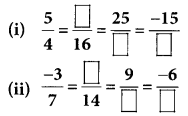
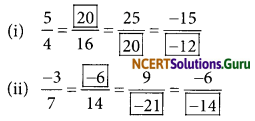


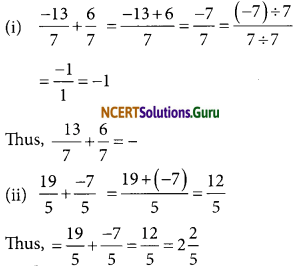

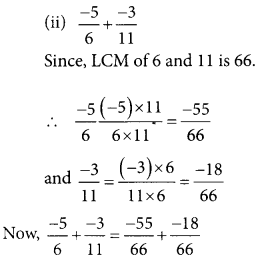
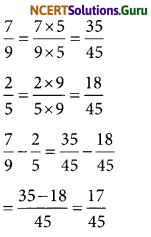
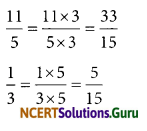

























 |
|












































